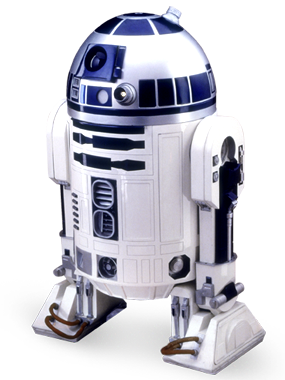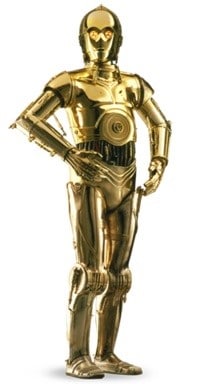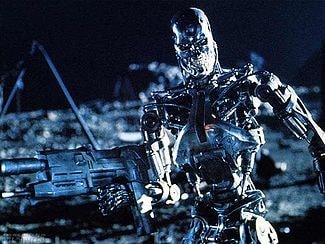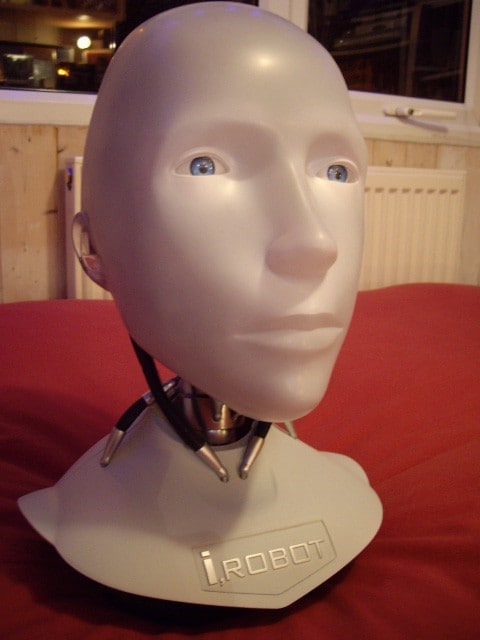A Funny Thing Happened on the Way to Becoming Human
Crossing the Uncanny Valley
Most people do not believe they interact or live with robots other than the ones we see on TV or in the movies. But, robots already play an important role in our lives and will in an ever-increasing way, whether we like it or not. Technically, we already obey robots. It's all in how we define them. Our traffic control systems are machines that give us orders. They help order our otherwise chaotic traffic structures to boost efficiency, safety, and usability of roads and highways. Depending on how we want to elasticize our definition of robotics, copy machines and coffee pots can also be considered dedicated little robots. They do what we can do, but faster, more efficiently, more repetitively, and in a more automated way.
These cold, faceless, inorganic machines don't threaten us, even though they do inconvenience us at times. As we technologically weave our society into a more machine-centric fabric, machines are going to take on more and more human attributes. This means that robots will try to look, act, and communicate with us more like humans do.
But, a funny thing happens on the way to becoming human. A repulsive emotion buried deep inside all of us flares up at a crossover point between clearly mechanical and clearly humanoid. This visually triggered effect has been called the "Uncanny Valley," a term coined by professor Masahiro Mori in 1970 based on a concept from Sigmund Freud. Interestingly, this psycho-physical-emotional reaction seems to be embedded within us like a genetic imprint.
In other words, robots that are very clearly machines do not tend to scare us. Likewise, robots that are VERY human don't frighten us. But, robots in between this valley do repulse and intimidate us. This is a buried physiological response to rather specific stimuli.
This article examines the Uncanny Valley phenomena, how it manifests, and cites several historical examples of envisioned robots and the emotional responses they are designed to evoke. The people who created these robots sculpted their visions of these machines based on the emotions they want to stimulate.
This is not simply a quest for aesthetics. As designers of the machines that people interact with, it is important to make sure that people accept the machines in their daily lives. For example, a rescue robot will not be effective if it scares children and other people in need. Service robots can be useful but services that require interaction with humans, such as Toshiba Corporation's communication android, are increasingly human-like in form.
From the Source
People's reactions to this Uncanny Valley effect have been demonstrated to be repeatable. In fact, the effect has been graphed as a mathematical function.

Figure 1: The presence of movement sharpens the slope of the Uncanny Valley. (Source: http://en.wikipedia.org/wiki/Uncanny_valley, http://spectrum.ieee.org/automaton/robotics/humanoids/the-uncanny-valley)
The Uncanny Valley reaction is not exclusive to humans. Evolutionary links to this reaction have also been demonstrated with experiments using monkeys. Many speculations have been made as to why this seemingly genetically coded response lives within us. Some say it is to prevent similar but different species from mating. Some say it is a part of the fight/flight response to alert us of potential danger. Others purport that it is part of an innate sense that seeks to protect ourselves from disease that makes us shy away from an organism that may be perceived as carrying a sickness. And still others claim this is a genetic memory from times way back before history encoded in mitochondrial DNA. Wherever the original source, the phenomenon clearly manifests itself repetitively.
The Uncanny Valley may not be purely a reaction to the physical. Faces in video games are still being studied regarding people's reactions to them. Animation, too, has been able to demonstrate this with cartoon characters kids like, and those that they don't. This is tapping into that subconscious area at an early age for the purpose of creating characters and artificial 'friends' for children.
And don't for one second think that media groups don't realize this. Note how cartoon, movie, and animated creations are designed specifically to be either liked, or feared, by children. The "cuteness factor" even extends from living to nonliving things. The large, Rockwellian eyes on children and even animals often elicits a sympathetic response. Machines can also leverage these attributes to facilitate emotional attachments.
On the other side of the coin, images of static robots that have not crossed the Uncanny Valley can arouse a "creeped out" response. Take, for instance, some of the design attempts to create robotics with real-life facial features. Even without motion, robots that look too life-like make humans uneasy. Motion compounds this uneasiness, especially if it is not fluid and natural. However, comical movements — such as the exaggerated movements exhibited by C-3PO in "Star Wars" — can actually disarm the uneasiness.

Figure 2: Saya the robot receptionist, created by Hiroshi Kobayashi at the Tokyo University of Science. Source
Emotional Attachments to Machines
Another important aspect that dovetails with the concept of the Uncanny Valley involves the human response to becoming attached to inanimate objects. We've all heard about — or may even know—someone who is "in love" with their car, phone, favorite video game, or motorcycle. Some people actually attribute higher values to their things than they do to other people and creatures. In some cases, humans can form emotional and relational bonds with machines. This is evident in the way younger generations embrace technology in an emotional way. A remote friendship can be formed with real emotional attachments to friends that one has never met. The machine is just the vehicle for those emotions to ride along. This is a mesmerizing attachment to a technological device that links an emotional attachment to unknown strangers.
This is an important concept to understand for those creating companion robots. An elderly and aging population or those afflicted with some form of dementia may benefit from a companion robot that is responsive enough to comfort and assist, yet also welcoming and non-intimidating.
The adoption of companion robots may be a valid approach as the number of aged outnumbers the number of young, and the costs associated with elderly assistance continue to grow each year. This provides just one more example as to how machines can be designed to replace humans, job function by job function.
By the same token, it has been foreshadowed by modern media that we are extremely close to experiencing emotional and physical relationships with robotic machines. Several sympathetic books and films portray robots emotionally, and even make them likable. Others show companion robots that function as domestic partners as well.
In many cases, like a loyal dog, the vision of an Asimov-style protector/companion machine would draw even little Timmy away from Lassie. But in order to achieve this level of trust, comfort, and ease, we must understand and overcome the Uncanny Valley. Otherwise these machines will remain, at least to human perception, cold and soulless.
Robots through History
Examples of robots throughout history demonstrate how humans perceive them as both friend and foe. Several stories also reveal how humans foresee their use and abuse, with some eventually rising up to control and decimate the populations. Of course, the appearance of these machines is very closely tied to how we react to them.
The earliest popular electro-mechanical representation of a robot occurred in the 1956 movie, "Forbidden Planet." Robby the Robot (Fig. 3) was a servant-machine and protector of a scientist and his beautiful young daughter.

Figure 3: (Source: Entertainment Earth)
Robby is faceless and humanoid in structure, and was made to be a non-threatening service machine. Robots such as these exist on the left-hand side of the Uncanny Valley spectrum, indicating a certain level of comfort and not fear.
Another example of a robot that is unthreatening to humans is the popular R2-D2 from "Star Wars" (Fig. 4). This robot is clearly very far from demonstrating a real human physique. In addition, R2-D2 has no discernable eyes, even though it is evident that it is equipped with sensors.
R2-D2 also tends to evoke a compassionate response from movie-watchers.

Figure 4: R2-D2 from "Star Wars" is another example of a non-humanoid and non-threatening robot. (Source: Wikipedia)
Taking another example from "Star Wars," the popular C-3PO robot (Fig. 5) is an example showcasing a human-like physique that is not resolute enough to cause fear. It is far enough left on the spectrum so as to not intimidate humans.

Figure 5: C-3PO from "Star Wars." (Source: Wikipedia)
As robots begin to look more like humans, the Uncanny Valley starts its descent. For example, the popular Terminator T-800 Model 101 robot from the movie series "Terminator" is skeletal in form and clearly incorporates a humanoid physiology and anatomy (Fig. 6). In addition, the use of a skull-type head taps an ingrained subconscious fear mechanism.

Figure 6:The Terminator. (Source: Wikipedia)
One of the best examples of a rendered mechanical facial construct that can demostrate the Uncanny Valley from both sides is from "I, Robot." In the robots from this movie, smooth contours and generic facial expressions are almost emotionless. During some scenes, the face can seem terrifying because it takes on attributes of anger and rage. At other times, the face can be soothing and calming, eliciting a sympathic response from the viewer. The eyes are a key component in generating human responses to these robots (Fig. 7).

Figure 7:A mechanical facial construct from the movie "I, Robot." (Source: Wikipedia)
Perhaps the most well-known modern incarnation of an artificial life form is that of Lieutenant Commander Data from "Star Trek: Next Generation." Again, the robot's humanoid appearance and actions push the personality past the Uncanny Valley into the likable region, even though he is seemingly emotionless. Lieutenant Commander Data exhibits innocence, curiosity, and even a child-like naiveté.
Another interesting point to note is that humans may experience feelings of fear and uneasiness when they come into contact with a modified human in real-life. Many prosthetics, robotics, or trans-human modifications can elicit a similar response.

Figure 8:Lieutenant Commander Data is an android played by human Brent Spiner on "Star Wars: The Next Generation." (Source: Wikipedia)
A Shifting Valley?
At this time, most of the relevant examples demonstrating the Uncanny Valley phenomenon come to us through the silver screen, but it is just a matter of time before humans come face-to-face with more robots. From assembly lines to the design of modern children's toys, robots have already taken a foot-hold and will only become even more common over time.
Robotic applications that cross industries such as healthcare, connected home, education and manufacturing are already in the works, but it is up to the creators of these machines to walk that very fine line of ensuring humans aren't repulsed by their creations.
As time goes on and robots become more commonplace, it will be interesting to see whether the Uncanny Valley itself shifts, or whether there will always be a threshold at which humans just cannot accept certain robots.